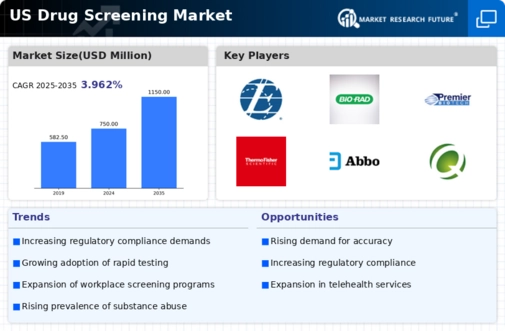Legalization of Cannabis
The legalization of cannabis in several states has introduced complexities to the drug screening market. As more states adopt laws permitting recreational and medicinal use, employers face challenges in establishing effective drug testing policies. This evolving legal landscape necessitates the development of new testing protocols that can accurately differentiate between legal use and impairment. Consequently, the drug screening market is adapting to these changes, with an increasing focus on developing reliable testing methods that address the nuances of cannabis use. This trend may lead to a surge in demand for specialized drug screening solutions tailored to meet the needs of employers navigating this new regulatory environment.
Rising Substance Abuse Rates
The drug screening market is experiencing growth due to the alarming rise in substance abuse rates across the United States. According to the National Institute on Drug Abuse, approximately 21 million Americans suffer from substance use disorders. This escalating crisis necessitates increased drug screening efforts in various sectors, including healthcare, law enforcement, and workplaces. Organizations are increasingly adopting drug testing protocols to ensure safety and compliance, thereby driving demand for drug screening services and products. The market is projected to expand as more entities recognize the importance of early detection and intervention in combating substance abuse, which is likely to enhance the overall drug screening market.
Workplace Drug Testing Policies
The implementation of stringent workplace drug testing policies is a significant driver for the drug screening market. Many employers are adopting comprehensive drug testing programs to maintain a safe and productive work environment. According to the Substance Abuse and Mental Health Services Administration, around 70% of substance abusers are employed, highlighting the need for effective screening measures. As companies face legal liabilities and safety concerns, the demand for reliable drug testing solutions is expected to rise. This trend is likely to bolster the drug screening market, as organizations seek to mitigate risks associated with substance abuse among employees.
Increased Awareness of Health Risks
Growing awareness of the health risks associated with drug use is propelling the drug screening market forward. Public health campaigns and educational initiatives are informing individuals and organizations about the dangers of substance abuse, leading to a heightened demand for drug testing services. This awareness is particularly pronounced in sectors such as education and healthcare, where institutions are implementing drug screening policies to promote safety and well-being. As the public becomes more informed about the implications of drug use, the drug screening market is likely to see sustained growth, driven by proactive measures aimed at prevention and intervention.
Technological Innovations in Testing
Technological advancements are reshaping the drug screening market, introducing innovative testing methods that enhance accuracy and efficiency. The development of rapid testing kits and point-of-care testing devices allows for immediate results, which is increasingly appealing to employers and healthcare providers. The market is witnessing a shift towards non-invasive testing methods, such as saliva and hair testing, which are gaining traction due to their convenience and reliability. As these technologies evolve, they are expected to drive growth in the drug screening market, catering to the rising demand for efficient and user-friendly testing solutions.

















Leave a Comment